The Samsung Galaxy S9 and S9+ Review: Exynos and Snapdragon at 960fps
by Andrei Frumusanu on March 26, 2018 10:00 AM ESTDisplay Evaluation & Power
The displays of the Galaxy S9’s don’t change much compared to the Galaxy S8’s. The S9 uses an upgraded AMOLED DDIC S6E3HA8 instead of last year’s S6E3HA6. The new panels are AMB577PX01 on the Galaxy S9 and an AMB622NP01 on the Galaxy S9+.
A nice addition with Samsung’s Android 8.0 OS on the Galaxy S8 and Galaxy S9 is the ability have fine-grained control over colour temperature – although it’s disappointing to see that this is limited to the Adaptive Display colour mode. The remaining colour modes continue Samsung’s tradition to provide different colour space modes. Adaptive Display is a wide gamut mode which is intentionally wide and doesn’t correspond to any standard. AMOLED Cinema targets the DCI P3 colour space, AMOLED Photo targets Adobe RGB and the simple “Basic” mode targets sRGB accuracy.
One big introduction of Android 8.0 was supposed to be the inclusion of wide colour gamut colour management support. This was enabled on Google’s Pixel 2 devices. To find out more how the Galaxy S9 behaves I wrote a quick app which check’s Android’s APIs. Unfortunately the Galaxy S9 doesn’t have any colour management support and switching colour modes through the APIs does nothing. There’s still a lot of questions remaining in terms of wide gamut support on Android, particularly for Samsung devices who make extensive usage of colour management and display modes through the mDNIe solutions on their AMOLED devices.
There’s a plethora of reasons of why Samsung could have decided not to enable support, some of them which are hardware requirements on the display pipeline. The Exynos 9810 and Snapdragon 845 both should support 10-bit display pipelines (which is not necessarily a requirement, but simplifies things) but for example the S6E3HA6 was still an 8-bit DDIC which complicates things and requires tone remapping and possibly dithering techniques. The situation is a bit of a conundrum and it’ll probably take some time before Samsung introduces a full 10-bit wide gamut software-to-display device. The Galaxy S9 for now remains the same as previous generation in terms of colour gamuts and colour depths.
And as always, measurements are performed with an X-Rite i1Pro 2 spectrophotometer, with the exception of black levels which are measured with an i1Display Pro colorimeter to achieve the most accurate results possible in an area where the i1Pro 2 can be somewhat unreliable. Data is collected and examined using SpectraCal's CalMAN software.
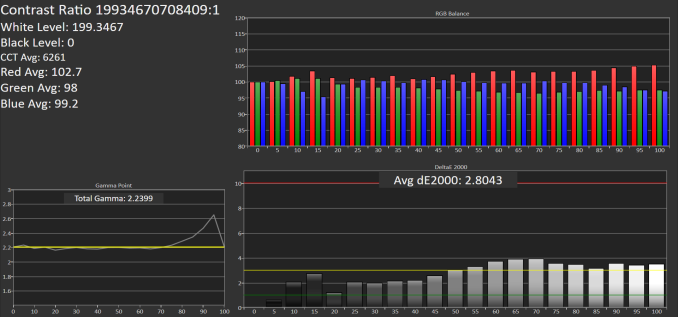
sRGB (Basic mode)
SpectraCal CalMAN
The Galaxy S9 and S9+ display generally the same characteristics as the Galaxy S8. Minimum brightness goes down to 1.5 cd/m² while manual maximum brightness tops out at 300-320 depending on colour mode. Auto-brightness boost in bright conditions will overdrive the panel at up to 625 cd/m² at 100 APL (full white) which is the same brightness as the S8, both in manual and auto modes.
The Galaxy S9 and S9+ units I have here still suffer from slightly too low colour temperatures both in sRGB and DCI P3 modes, coming in at around 6250K, slightly better than the Galaxy S8 unit I have which also was too red at 6150K. Samsung’s Adaptive Mode default to higher colour temperature of 7000K, however in that mode it’s a non-issue as you’re able to adjust the colour balance to one’s preference. The Galaxy S9 and S9+ showcase better total gamma than the S8 units I have here, coming in at 2.23 on the S9’s vs 2.13 on the S8.
Greyscale accuracy is good even though we’re veering slightly too much into the reds because of the under-targeted colour temperature.
In direct sunlight the S9’s retrain fantastic readability thanks to the high-brigthness mode that the phone switches to. In this mode the display ignores the selected display mode and goes into a special very saturated and very low gamma mode to improve legibility.
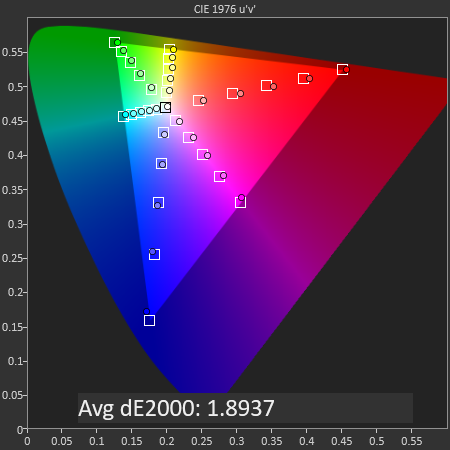
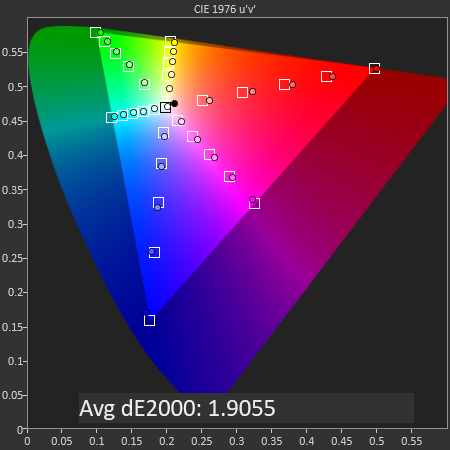
sRGB (Basic mode) & DCI P3 (AMOLED Cinema) Saturations
SpectraCal CalMAN
In terms of gamut and saturations accuracy the S9+ behaves excellently in sRGB and DCI P3 modes. However I did see that the mid-level red saturation points were too high and this prohibited the S9’s from reaching lower overall dE2000 figures. Because I measured the exact same deviation between the S9 and S9+ I believe this to be a calibration issue of the mDNIe profiles rather than an issue of the panels which Samsung could theoretically fix through software if they wanted to (along with the colour temperature being too red).
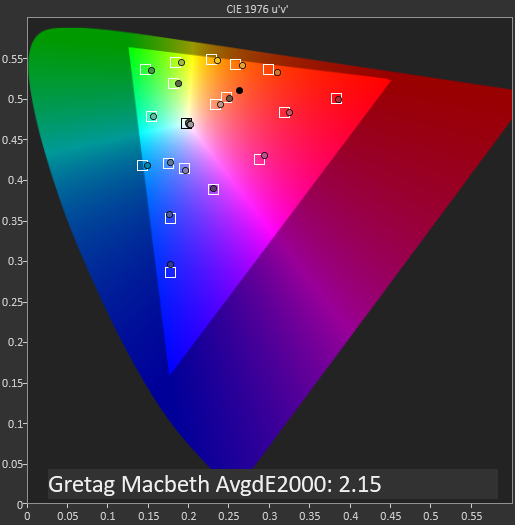
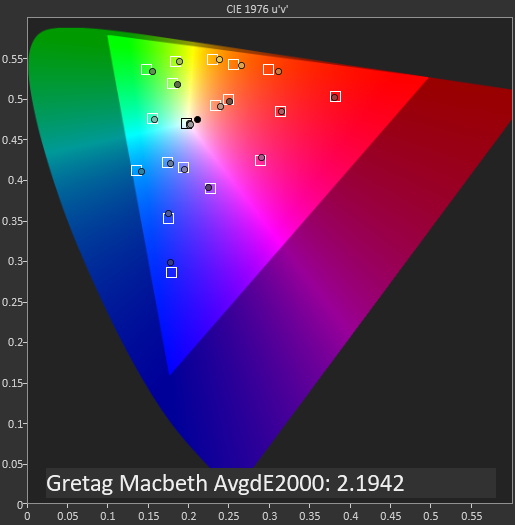
sRGB (Basic mode) & DCI P3 (AMOLED Cinema) GMB
SpectraCal CalMAN
In the GMB charts the Galaxy S9 and S9+ again posted identical figures with overall good accuracy in sRGB and DCI P3 modes. Again the biggest mis-alignments here happen in the red tones are they are too saturated than what they should have been.
Something we’ve never covered before is a certain behaviour of AMOLED screens at low brightness and dark contents. Samsung has for generations had issues with transitions from complete black (pixels off) and lowest level colours. Now with having more competition in the OLED scene both from LG in terms of panels and from Apple with the iPhone X, I found it interesting to compare how the different devices behave.
This sort of evaluation is extremely hard to capture as it can’t really be measured with tools into a quantized figure. I resorted to simply capturing the phone’s screens with a DSLR at long exposure times. Alongside the long-exposures which exaggerate the brightness of the scene compared to the reference image, I also included the same image captures but with the high-lighted shadow clipping showcasing the areas of complete black of the screens. The phones had all been calibrated to a fixed 20cd/m² brightness to have an apples-to-apples comparison.
The Galaxy S9 and S9+ both are darker and more even in brightness than the Galaxy S8. This matches our measurement which showed the S9’s have higher gamma than the S8 (for our units). The Galaxy S9’s provided a better representation of the source material than the S8. There is a difference between the S9 and S9+ as the S9+ seemed to have a higher gamma or more clipping between black and the darkest areas. The problem here is that this clipping gradient isn’t smooth enough and in motion this results in very noticeable moving artefacts.
The iPhone X behaved very differently than any Samsung devices and provided a significant image quality advantage in dark scenes. When looking at the shadow clipping highlighting that Apple is doing some very fine dithering between fully dark areas and the next highest brightness levels. When in motion the iPhone X just provides an extremely good experience in dark scenes with little to no visible artifacts.
The Pixel 2 XL comes with an LG panel and DDIC. The results here are a complete mess as not only does the Pixel 2 XL have issues with the dark areas, but actually the gamma curve at low levels is far too high and this clips actual detail of the image into complete black. The LG V30 has the same issues and I hear this is a hardware limitation on the way LG handles brightness control through PWM – it’s not able to retain sufficient ADC bit depth resolution at low brightness and causes a more compressed image.
Apple’s screen also doesn’t suffer from the “purple smudging” when transitioning between black areas. This seems to be caused by a lag in the response-time of the blue subpixels, not able to shut off quickly enough. The point here is that if Apple can handle dark scenes at low brightness levels at good quality, then so should Samsung, so here’s hoping Samsung’s engineers can focus on this issue and improve it in future generations.
| Screen Luminance Power Efficiency 100% APL / White |
||||||
| Device | Screen Luminance Power at 200cd/m² |
Luminance Power (mW) / Screen area (cm²) Efficiency |
||||
| Galaxy Note 5 | 504 mW | 5.64 | ||||
| Galaxy S6 | 442 mW | 5.99 | ||||
| Galaxy S9 | 563 mW | 6.69 | ||||
| Galaxy S8 | 590 mW | 7.01 | ||||
| Galaxy S5 | 532 mW | 7.21 | ||||
| Galaxy Note 4 | 665 mW | 7.22 | ||||
| Galaxy S5 LTEA | 605 mW | 8.20 | ||||
| Galaxy S4 | 653 mW | 9.22 | ||||
A big question I wanted to see an answer to is if the Galaxy S9 had improved in terms of power consumption and efficiency. As it stands, power on the S8 and S9 were nearly identical and the measured difference was within 5%. We haven’t seen an improvement in AMOLED emission power efficiency in a few generations now so I do wonder if my projection of AMOLEDs surpassing LCDs in overall efficiency from 3 years ago has actually happened or not. I didn’t have time to go in-depth in other current generation devices for this article, but I’ll make sure to give an update in a separate piece in the near future.
Overall the Galaxy S9 screens behave mostly the same as the ones on the Galaxy S8’s. The only differences between the screens that will be visible is the higher gamma at low brightness levels which slightly improve the quality. The Galaxy S9’s screens are still one of the best on the market and I don’t really see any deal-breaking issues with the phones in that regard.


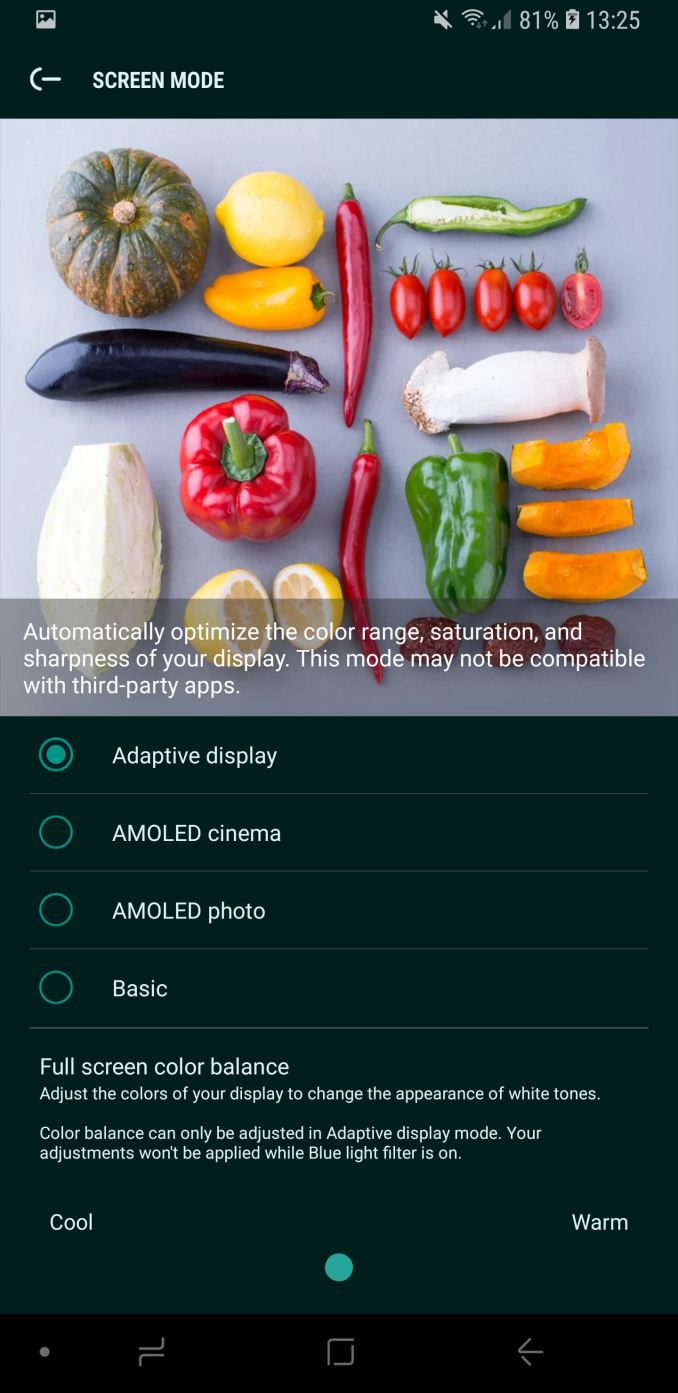
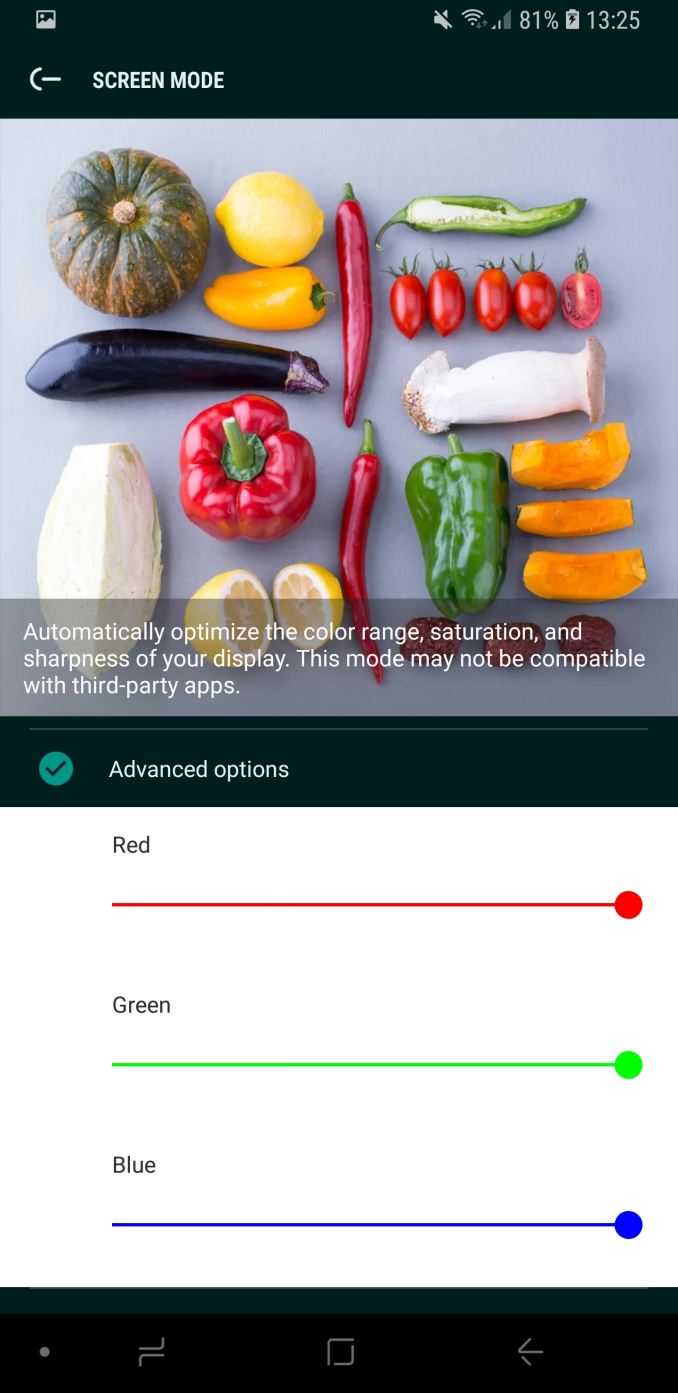














190 Comments
View All Comments
robertkoa - Tuesday, July 3, 2018 - link
Yes. Has a great built in battery monitor that puts apps to sleep but they become immediately available.Also Location OFF unless using GPS ...Avoid having Apps and Sites give you notifications.
Avoid unnecessary extra tabs opened.
Screen brightness at 30% indoors.
I squeeze a lot of SOT on 4GLTE 6 hours browsing 40 minutes of calls 40 minutes of Youtube 20 minutes of emails on a charge.
Have not used Camera for a long time yet.
8 to 9 hours SOT.Qualcomm S9 USA not sure what people are doing who get half this.
I AM afraid to download the new .75GIG software update...why do they need .75GIG for security patches...?
Larger Operating System with constant security in deep background APPS could kill my battery life ...
peevee - Thursday, April 5, 2018 - link
WOW, A55 cores are so tiny compared to M3, one M3 cores takes as much silicon as 8 A55 cores. In the same amount of silicon, they could have had 1 M3 core and ~28-30 A55s. It would be just as fast in single-thread tasks but much faster AND more energy-efficient in multi-thread ones.peevee - Thursday, April 5, 2018 - link
Do I see it correctly that good old 820 is both most efficient and one of the fastest in most cases? Such a degradation!peevee - Thursday, April 5, 2018 - link
"we see the Snapdragon 845 within spitting distance of the Snapdragon 835’s energy usage throughout most of the workloads, sometimes winning and sometimes losing"Where 845 is winning in energy usage? What are you talking about? Either something is wrong with your graphs (color coding?), or 820 is significantly better than 835 which is significantly better than 845.
mkstowegnv - Thursday, April 5, 2018 - link
Thank you for putting all the work into this valuable review. But. You did not talk about GNSS - GPS, GLONASS, etc. (and AT has not had a story involving GNSS for 5 years). You can only do so much and it is another world of expertise, but it would be particularly valuable to look into GNSS for this phone. 2018 was supposed to be the year of phones with multifrequency GNSS leading to centimeter accuracy (and more to the point for the average user much better and faster performance in urban canyons, thick forests and other unfavorable environments and times). Broadcomm's BCM4775x series of L1, L5 chips was going to make this happen (but they have remained mum about which phones would use the chip). The problem is that Qualcomm SOCs are unlikely to incorporate their archrival's products, and all the leaks and previews of all the flagship phones for the next year indicate Qualcomm Snapdragon SOCs. Huawei uses non-Qualcomm but their just released p20 uses the previous generation, L1-only Broadcom chip. The only BCM4775x phone that anyone has seen and maybe the only one for the forseeable near future is the Exynos version of the S9+ which Techinsight's teardown and XDA hackers confirm has the BCM54772. It was not announced or documented by Samsung, and XDAers still don't know if it is picking up the L5 signal in an accessible way. What heroic figure(s) could possibly measure and compare GNSS accuracy in recent phones and possibly hack the Exynos S9+ to use L1 and L5 and get the best accuracy?KD323 - Thursday, May 17, 2018 - link
Thanks for the writeup! By the way, what do you think of these wooden phone cases for S9/S9 Plus?https://kaloadesigns.com/collections/galaxy-s9Peaches - Sunday, May 27, 2018 - link
Does these tests mean, that The E9810 with The CPU-Limiter from The Power Saving Mode activated , is as fast and more efficient than The E8895? BTW:awesome test and i love Hose detailed and fact-based you are.Taleim - Wednesday, May 30, 2018 - link
I hear that the may update improves battery life, any chance of running the tests again? CheersLodestone - Thursday, August 30, 2018 - link
Same here. Would greatly appreciate if you could run the exynos battery tests again to see if updates have improved the problem.CyberRain - Wednesday, August 8, 2018 - link
How to Catch a Cheating SpouseIt offers you not only to view the files on the device, but also download them on your personal computer.
The tool gives you absolute anonymity. Your spouse will never find out you spy on his/her cell phone.
There is no need on possessing the target device. You can spy on your Spouse remotely. The entire process does not need any physical access.
contact: Mobile Hack Expert